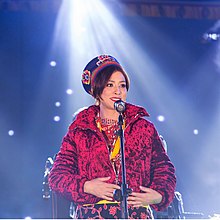Tamang Selo: Difference between revisions
Citation bot (talk | contribs) Alter: title. | Use this bot. Report bugs. | Suggested by Eastmain | #UCB_webform 398/598 |
Tabletop123 (talk | contribs) |
||
| Line 13: | Line 13: | ||
*[[Navneet Aditya Waiba]] |
*[[Navneet Aditya Waiba]] |
||
*[[Tamang people]] |
*[[Tamang people]] |
||
*[[Music of Nepal]] |
|||
*[[Demographics of Nepal|Ethnic groups of Nepal]] |
|||
==References== |
==References== |
||
Revision as of 09:51, 30 May 2023

Tamang Selo (Nepali: तामाङ सेलो) is a genre of Nepali folk song sung by the Tamang people of Nepal and is widely popular among the Nepali-speaking community in Nepal, in India, and around the world. It is usually accompanied by the Tamang instruments: Damphu, Madal and Tungna. A Selo could be very catchy and lively or slow and melodious and is usually sung to express love, sorrow and stories of day to day life.[1]
Hira Devi Waiba, pioneer of Nepali folk songs and Tamang Selo

Hira Devi Waiba is hailed as the pioneer of Nepali folk songs and Tamang Selo.[2] Her song "Chura ta Hoina Astura" (Nepali: चुरा त होइन अस्तुरा) is said to be the first Tamang Selo ever recorded.[3] Waiba has sung nearly 300 songs in a career spanning 40 years. Waiba's children Navneet Aditya Waiba and Satya Aditya Waiba have carried the legacy further by continuing on her footsteps. Navneet and Satya are the only individuals in the Nepali folk music genre who produce authentic traditional Nepali folk songs without adulteration or modernisation.[4][5]

See also
References
- ^ "Performing Arts, Songs of the Tamang People". Archived from the original on 2016-06-05.
- ^ "The Telegraph - Calcutta (Kolkata) | North Bengal & Sikkim | Pioneer of Nepali Folk Songs". www.telegraphindia.com. Archived from the original on 2018-02-16. Retrieved 2018-03-04.
- ^ "चुरा त होइन अस्तुरा - पहिलो तामाङ सेलो गीत ? - Tamang Online". Tamang Online. 2016-12-07. Archived from the original on 2018-03-04. Retrieved 2018-03-04.
- ^ "Songs of Tribute". The Himalayan Times. 2017-01-10. Retrieved 2020-05-04.
- ^ "Daughter revives mother's songs". www.telegraphindia.com. Retrieved 2020-05-04.
